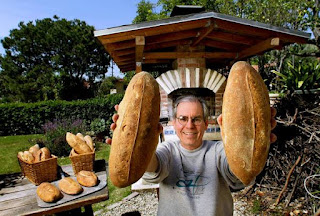Do
you have a colleague who makes fantastic apple pies for sale at work? Have you
ever paid a few dollars to the kid next door for his tray of fresh baked cookies?
Perhaps the above scenarios are not strange to you. However, did you know that
baked goods trading without a permit in California is considered illegal?
Prior to January 2013, California had a very strict homemade food law that disallowed a
lot of amateur of bakers from selling their savory creations from home. A local beloved
baker in Silverlake, California, Mark Stambler, was one of the thousands bakers
that suffered from the old regulations. Having over 30 years experience of baking artisan bread , Stambler started to sell bread prepared in his home
kitchen to local restaurants. However, the Department of Health came to stop him. It upset him as it was impossible for him to continue selling if he
has to follow the law.
 |
| Mark Stambler with His Homemade Artisan Bread Source: Assemblyman Mike Gatto's blog |
According
to Stambler, "If I want to sell bread in a store anywhere in Los Angeles
County, I basically have to own a wholesale food processing facility.
Period." No doubt, he states the concern of many other home
bakery business owners. Before the new bills were passed, bakers were required to have a commercial kitchen which would cost at least a few thousand dollars in the Los Angeles area.
After learning about Stambler's story, Assemblyman Mike Gatto decided to
help him as well as other potential small business owners. He drafted the new Cottage Food Act bill after working with some scientists, nutritionists and the
government. The new bill was finally passed on September, 2012 and was
effective as of January, 2013.
The
New California Cottage Food Act
The
new law allows small (at home) business owners to sell their homemade baked
goods to others with a permit. The permit is classified into 2 classes: one
permits the owner to only conduct direct sale with customers, and the other permits both direct and indirect sale, such as online transactions and selling
to restaurants.
The
cottage food act covers a list of foods classified as "non-hazardous".
These foods do not contain cream, and aren't easily spoiled (bacteria is unlikely
to grow even under room temperature). Here is the list:
 |
| Cottage Foods Source:Barfblog |
- Baked goods without cream, custard, or meat fillings, such as breads, biscuits, churros, cookies, pastries, and tortillas
- Candy, such as brittle and toffee
- Chocolate-covered nonperishable foods, such as nuts and dried fruit
- Dried fruit
- Dried pasta
- Dry baking mixes
- Fruit pies, fruit empanadas, and fruit tamales
- Granola, cereals, and trail mixes
- Herb blends and dried mole paste
- Honey and sweet sorghum syrup
- Jams, jellies, preserves, and fruit butter that comply with the standard described in Part 150 of Title 21 of the Code of Federal Regulations
- Nut mixes and nut butters
- Popcorn
- Vinegar and mustard
- Roasted coffee and dried tea
- Waffle cones and pizelles
- Other foods that the Director of the California Department of Public Health chooses to add
The
application process for the permits is simple. There are no more complicated
kitchen inspections. All you have to do is fill out an application form online,
consent to the ingredients sourcing, agree to sanitizing and labeling rules, and
finally pay the small permit fee then you are done with the registration
procedure. Next, you will have to take an online food handler course (which
lasts less than 2 hours) and pass a course related test. After that, all the
procedures are complete and you are good to go!
Potential
small businesses should be aware of two conditions in the new cottage food
act. First, the act only covers small businesses with a maximum of two people
in employment: the owner and one extra employee (exclude household's members
that live in the home where the production take place). Second, the maximum
income of this small business is $32,000 and it’s expected to grow to $50,000
in 2015.
Under
current economic conditions, the new law may help many households to increase
their income with just a small cost, to encourage people to continue with what they are passionate
about, and to provide potentially cheaper and a greater number of food options for consumers. Thus, the
households will continue to improve their lives with the higher income, which
will also be beneficial for the economy as a whole.
The
original bill document is rather long, but if you are interested in reading it,
you are welcome to click here.
No comments:
Post a Comment